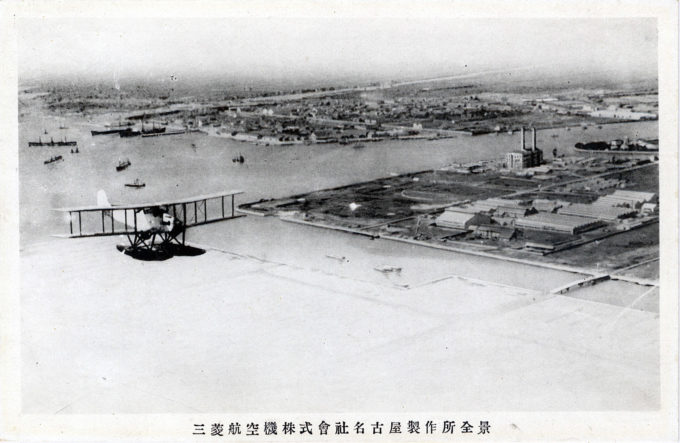
Nagoya Aircraft Works, Mitsubishi Aircraft Co., Nagoya, c. 1925, being overflown by a prototype twin-float 2MT4 (“Ohtori”) reconnaissance-scout biplane. Designed to be catapult-launched from a naval vessel (e.g. a battleship), the prototype was completed in March, 1925, but ultimately performed unsatisfactorily and was later scrapped. During the Pacific War, Mitsubishi’s Nagoya aircraft factories — responsible for producing the “Zero” and “Zeke” fighters, and “Betty” bombers — were the first sites targeted for bombing when B-29 raids on the city began in December, 1944.
See also:
Mitsubishi 2MR4 (Type 10) Carrier Reconnaissance biplane, c. 1930.
“Mitsubishi Heavy Industries Ltd. ranked first among Japanese industries in weight of airplanes produced because of the large number of relatively heavy bombers it assembled but ranked second in number of airplanes produced.
“… Mitsubishi’s interest in airplanes stems from 1918 when Dr. Kumezo Ito was sent to France to study the role aircraft had played in the first World War.
“In 1920 the Mitsubishi Internal Combustion Engine Co. Ltd. was registered as an airplane manufacturing company with its plant at Kobe.
“The nucleus for this company was separated from the shipbuilding and other engineering activities of the Mitsubishi holding company [and in] 1922 aircraft activities were shifted to Oemachi on the southern outskirts of Nagoya. These activities grew and in 1928 the company changed its name to the Mitsubishi Aircraft Co.
“Soon afterward a branch of the company was established in Tokyo as the Tokyo Engineering Works but in 1934 a change in policy regrouped and amalgamated all Mitsubishi industrial activities under a single company the Mitsubishi Heavy Industries Ltd. Each phase of the corporation’s activities — shipbuilding, aircraft, etc. — was organized as a separate works division.
“All aircraft activities were [then] grouped under the name of the Nagoya Aircraft Works at Oemachi, Nagoya, although manufacture of a few parts for engines was still undertaken by its general engineering works in Tokyo and Nagoya.
“In 1935 the Nagoya Aircraft Works comprised an airframe department and an engine department. New and improved plant facilities were installed for the manufacture of radial engines much of the modern machinery having been purchased in the United States.
“Shortly afterward in 1936 the aeroengine activities were separated from those of the airframe works under a separate works manager.
“… Between 1936 and 1939 research and development activities of Mitsubishi were at a peak. Prototypes of the ‘Zeke’ fighter and ‘Betty’ bomber were under development for the Navy and ‘Dinah’ and ‘Peggy’ for the Army. [The] Oemachi research facilities were expanded to cope with these activities and new land dredged from Nagoya harbor was utilized to accommodate enlarged production lines.”
– U.S. Strategic Bombing Survey, Aircraft Division, June 1947

